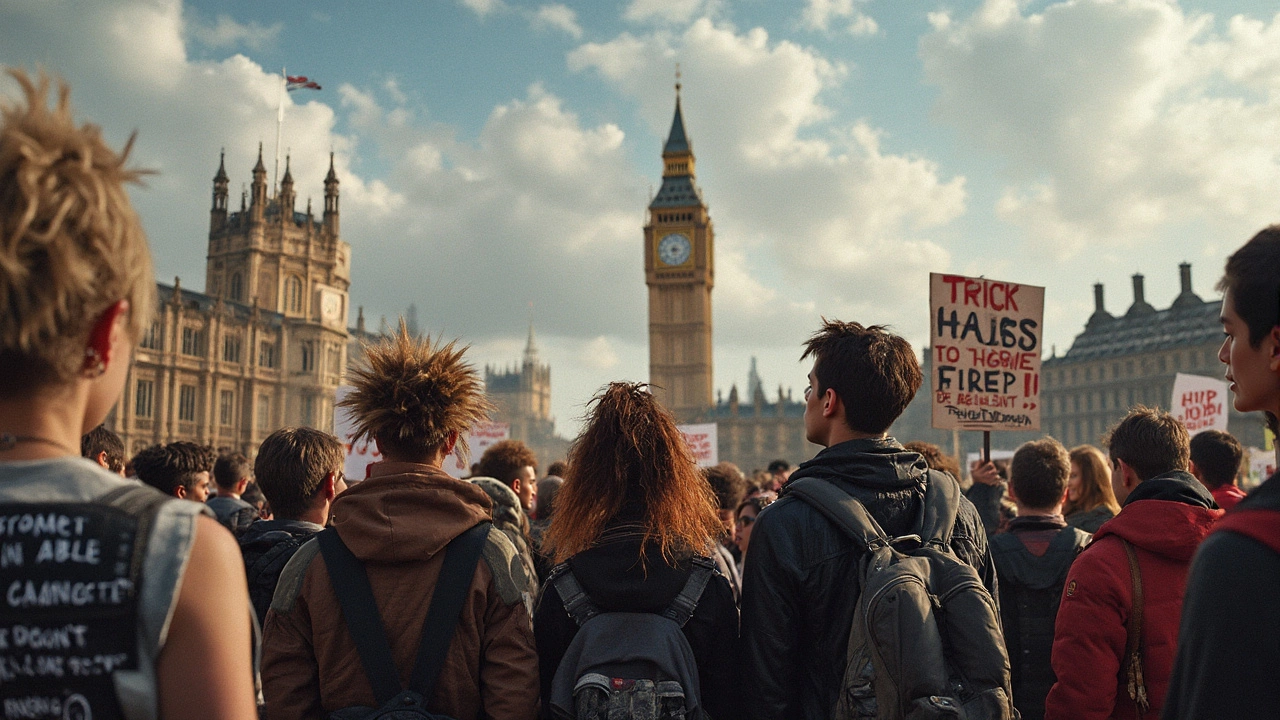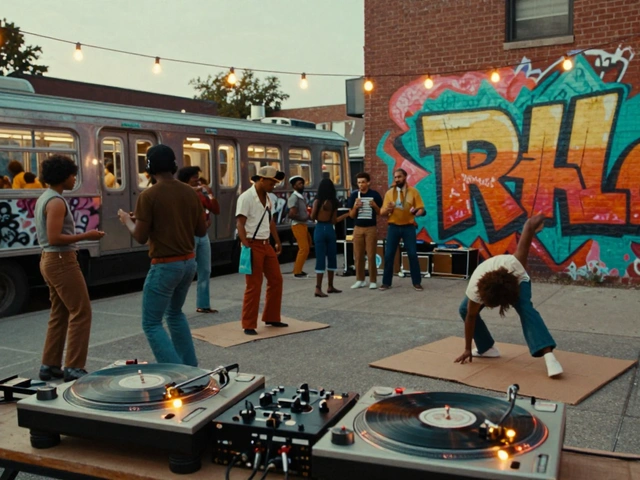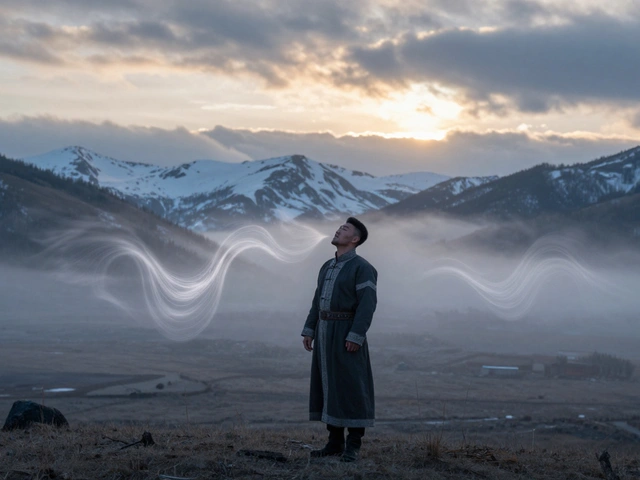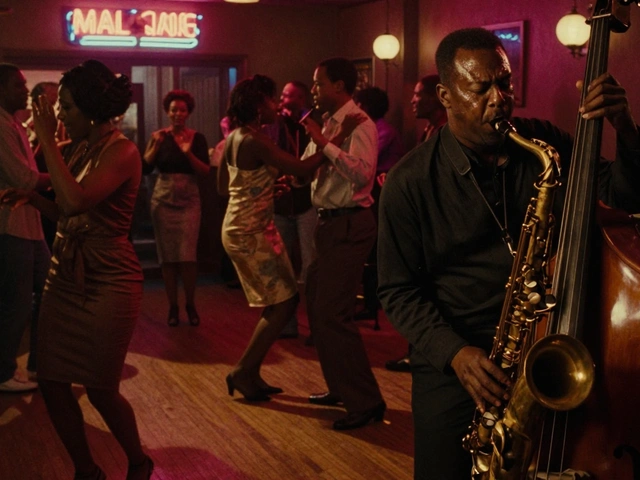Music and rebellion go hand in hand. Change doesn’t always start with a politician—it often begins with a song. Different music genres aren’t just about style or sound; they’ve been tools for pushing back, raising voices, and calling for action.
Think about how quickly a protest chant can catch on. Now imagine that energy packed into a track you hear everywhere—at rallies, on playlists, maybe even on your favorite radio station. That’s how genres like hip-hop, punk, and folk became much more than just music; they turned into weapons for challenging unfair systems and giving people a sense of unity.
If you’ve ever wondered why certain songs keep popping up in social movements, or how some genres just seem to ‘fit’ the mood of a protest, you’re not alone. There’s a pattern, and understanding it can help you spot new waves of change before they hit the headlines.
- Genre and Rebellion: Why Style Matters
- Folk and Protest: The Original Anthems
- Hip-Hop and Rap: Urban Voices for Change
- Rock, Punk, and Counterculture
- Pop Music: When Mainstream Joins The Movement
- Tips: Spotting Social Change in Songs
Genre and Rebellion: Why Style Matters
People don’t just listen to music—they use it. When you look at social movements, you’ll notice that certain music genres almost always show up as the soundtrack. It’s not a coincidence. The style of music sends messages, sometimes louder than the lyrics themselves.
Take punk, for example. It’s raw, loud, and kind of messy on purpose. That whole ‘no rules’ vibe made it perfect for young people fed up with the system in the late ’70s and ‘80s. Sex Pistols’ "God Save the Queen" wasn’t just a song—it was a middle finger to the government right during the Queen’s Jubilee.
On the other side, folk music, with its bare-bones sound and simple storytelling, gave regular people a way to share their real-life struggles. Bob Dylan’s "The Times They Are a-Changin’" was picked up by civil rights marchers because it felt honest. You could grab an acoustic guitar and join in without any fancy training.
Now, jump a few decades. Hip-hop, born in New York’s Bronx in the ’70s, turned into a global voice for folks with no political power. It’s direct, it’s personal, and it tackles hard truths. Grandmaster Flash’s "The Message" dropped in 1982 and cut through the noise with lines about poverty and street life.
Certain genres just click with certain movements. Why? Because their sound, look, and even the attitude of the artists tap straight into the mood of the people. Fast, angry guitars work for protest, while tracks with strong bass and clear lyrics help rally a crowd. It’s not just about having a beat you can dance to—it’s about matching the energy of the moment.
When researchers at the University of Cambridge looked at protest music in the 20th century, they found spikes in new genre popularity almost every time there was a major social movement—especially with punk, folk, and hip-hop making the biggest leaps.
| Genre | Known For | Social Movement Example |
|---|---|---|
| Punk | Fast, angry, simple | Anti-establishment riots (UK, 1970s) |
| Folk | Storytelling, easy to play | Civil rights marches (USA, 1960s) |
| Hip-hop | Bold, direct, streetwise | Black Lives Matter protests (Worldwide, 2010s-2020s) |
So, next time you’re curious why certain songs become anthems for change, look at the style as much as the lyrics. The genre is the secret sauce. Mix the right one with a powerful message, and you’ve got a movement on your hands.
Folk and Protest: The Original Anthems
Folk music has always hit home during tough times. Back in the 1960s, it turned into the soundtrack for huge social movements in the U.S.—think civil rights marches and anti-war rallies. Artists like Bob Dylan, Joan Baez, and Pete Seeger tackled topics no one else wanted to say out loud. Their songs weren’t just catchy; they got people thinking and acting.
Bob Dylan dropped “Blowin’ in the Wind” in 1962, and you could hear it at almost every protest from then on. That song became a question-and-answer session for a whole generation wondering why things were the way they were. Joan Baez sang at Martin Luther King Jr.’s marches, making "We Shall Overcome" a staple of the social movements playlist. Even before these icons, Woody Guthrie wrote “This Land Is Your Land” in 1940, shaping protest music for decades.
It’s not just a U.S. thing, either. In Chile, Victor Jara risked his life for protest music, while in South Africa, folk blended with local sounds to fight apartheid. These songs helped people realize they weren’t alone, which is a big deal when you’re up against an unfair system.
| Artist | Iconic Protest Song | Movement/Context | Year Released |
|---|---|---|---|
| Bob Dylan | Blowin’ in the Wind | Civil Rights | 1962 |
| Joan Baez | We Shall Overcome | Civil Rights | 1963 |
| Woody Guthrie | This Land Is Your Land | Worker’s Rights | 1940 |
| Victor Jara | Te Recuerdo Amanda | Chilean Democracy | 1969 |
Want to understand what folks were battling for? Just look at the lyrics—straightforward, raw, and aimed right at real-life issues. If you want to support a cause today, don’t underestimate the power of picking up a guitar or sharing an old protest song. These tracks still show up at marches, proving that folk’s influence hasn’t faded one bit. If you’re building a protest playlist or just digging into history, these are some of the first songs to check out.
Hip-Hop and Rap: Urban Voices for Change
No music genre has been as outspoken about real-life struggles as hip-hop and rap. Born in the Bronx during the late 1970s, these styles were never just about beats or flashy rhymes. They grew from daily realities—poverty, injustice, and the constant fight to be heard. That’s why, when it comes to social movements, you’ll often find hip-hop front and center.
Artists like Grandmaster Flash and the Furious Five didn’t just want a hit record. Their 1982 track “The Message” spelled out the problems in their neighborhoods. Fast forward to the '90s—Public Enemy, Tupac, and N.W.A. pulled zero punches. N.W.A.’s controversial “F*** tha Police” became an anthem for people pushed around by the system. These artists didn’t sugarcoat their experiences; they broadcast what communities were living through.
But it’s not all history. Think about Kendrick Lamar’s “Alright,” which became a rallying song for Black Lives Matter protests across the U.S. in 2015. Or Childish Gambino’s “This Is America,” which unpacked issues like police brutality and racism through both music and viral video in 2018. Hip-hop stays relevant because it puts a spotlight on problems most folks would rather ignore.
Numbers don’t lie—hip-hop is now the most popular music genre in the U.S., according to a 2017 Nielsen report. This means messages embedded in hip-hop tracks reach millions, making a real impact with every stream and share.
| Year | Artist | Song | Social Movement/Issue |
|---|---|---|---|
| 1982 | Grandmaster Flash and the Furious Five | The Message | Urban poverty, inequality |
| 1988 | N.W.A. | F*** tha Police | Police brutality |
| 2015 | Kendrick Lamar | Alright | Black Lives Matter |
| 2018 | Childish Gambino | This Is America | Racism, gun violence |
Curious about spotting protest hip-hop in your playlist? Lyrical content is key. Listen for songs that talk about injustice, call out leaders, or mention real events. Artists often mention police, neighborhoods, or specific protests. If you want to dig deeper, follow hip-hop news outlets—these often highlight new tracks born out of current issues.
Last tip—look beyond the hits. Local artists and underground rappers tend to tackle issues in their communities way before the mainstream catches on. These songs might not make it to the top charts, but they’re a goldmine when it comes to raw, honest voices for change.
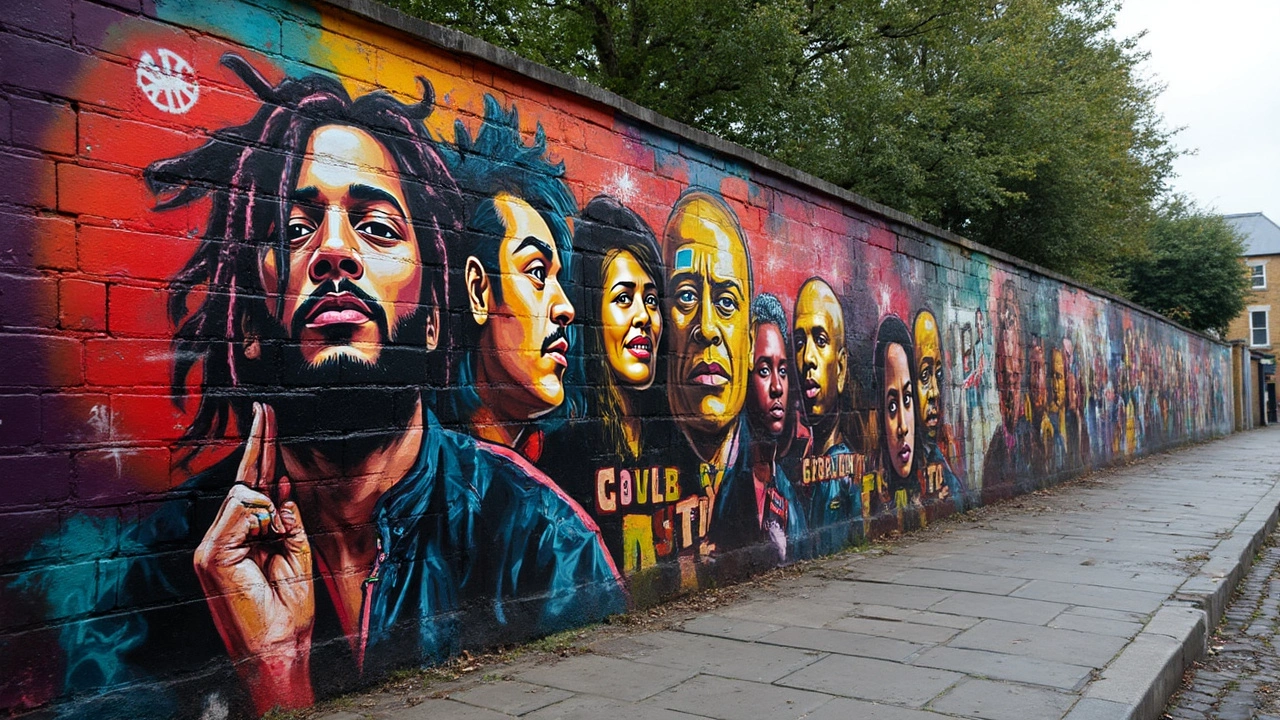
Rock, Punk, and Counterculture
Here’s where things get loud—literally. Rock and punk aren’t just genres people blast from their speakers. These styles have a wild history of flipping the script and giving outsiders a megaphone. Remember The Clash shouting "London Calling," or Rage Against the Machine telling folks to "Take the Power Back"? Those weren’t just catchy lines; they were direct shots at the system.
Rock music first became rebellious in the 1960s. Bands like The Beatles and The Rolling Stones started pushing against social rules, but it was artists like Jimi Hendrix and Janis Joplin who really pushed boundaries, playing at rallies and festivals like Woodstock, which pulled in over 400,000 people in 1969. That’s nearly the population of a small city, all hearing messages about peace, war, and rights.
Punk turned things up another notch. It was raw, fast, and didn’t care about polished sound. Acts like the Sex Pistols and Ramones weren’t afraid to shout about class issues, police brutality, and government control. In the late 1970s, when jobs were scarce and folks were angry, punk bands gave kids something honest to scream along with. Socially, that mattered a ton—sometimes a scrappy punk show pulled bigger crowds than any public speech.
It’s not just old history either. Punk and rock still jump into modern movements. Green Day’s "American Idiot" became a protest anthem in the 2000s, especially during the Iraq War. Punk events like Riot Fest and DIY house gigs often double as fundraisers for causes like reproductive rights or community bail funds. The connection between these genres and counterculture is as tight now as it was forty years ago.
Here’s a quick look at some famous rock and punk songs that fueled social movements:
- Bands like Rage Against the Machine (Protest against police brutality and government corruption)
- The Clash with "White Riot" (Race and riot issues in late-70s England)
- Green Day with "Holiday" and "American Idiot" (Critique of war and mass media)
- Sex Pistols with "God Save the Queen" (Anti-establishment anthem during the Queen’s Jubilee)
If you like numbers, take a look at how these protest songs broke through. Here’s a quick table of impact stats:
| Song/Band | Year Released | Chart Peak (US/UK) | Known Social Movement |
|---|---|---|---|
| "London Calling" - The Clash | 1979 | US: #30 / UK: #11 | Anti-racism, Nuclear threat |
| "Killing in the Name" - Rage Against the Machine | 1992 | UK: #1 (in 2009) | Police brutality, Anti-authority |
| "God Save the Queen" - Sex Pistols | 1977 | UK: #2 | Monarchy criticism, British class issues |
| "American Idiot" - Green Day | 2004 | US: #61 / UK: #3 | Anti-war, Anti-media |
The big thing to remember: these genres are more than music styles—they’re blueprints for social movements. If you’re looking for the heartbeat of a protest, check the rock and punk playlists first.
Pop Music: When Mainstream Joins The Movement
When pop music jumps into a social movement, you notice. Suddenly, messages that started out in smaller scenes or fringe genres are all over the radio, social media, and even commercials. Pop is everywhere, and that’s exactly why it’s a game-changer. One hit song repeated across countless platforms can turn a niche cause into a global conversation almost overnight.
Take Michael Jackson’s “Man in the Mirror” from 1988. Yeah, you’ve heard it a million times, but that track was actually about self-reflection and social responsibility. Or think about Lady Gaga’s “Born This Way” in 2011—an anthem for the LGBTQ+ community that topped the charts and got played at pride parades worldwide. Then there’s Beyoncé’s “Formation,” which quickly became tied to Black Lives Matter marches and conversations about racial justice.
Pop artists often have the budget and reach to make huge statements, whether in their music videos, live shows, or social media posts. When they speak up, the world tends to listen. In 1985, “We Are the World” brought together the biggest stars of the time—Michael Jackson, Lionel Richie, Bob Dylan, Cyndi Lauper, and others—raising over $60 million for African famine relief. Fans didn’t just get a catchy song; they got a message and a reason to act.
| Pop Song | Movement/Message | Impact Year |
|---|---|---|
| Man in the Mirror | Personal/Social Change | 1988 |
| Born This Way | LGBTQ+ Rights | 2011 |
| Formation | Racial Justice | 2016 |
| We Are the World | Famine Relief | 1985 |
Sometimes, pop songs become rallying cries even when that’s not the artist’s main goal. Remember how Katy Perry’s “Firework” got picked up by anti-bullying campaigns, or how Taylor Swift’s “You Need To Calm Down” turned into a statement for equality? The secret sauce here is accessibility—pop tunes are easy for everyone to listen to, sing along with, and share. That makes music genres like pop super powerful in starting and spreading important conversations.
Want to spot when pop music is about more than just catchy hooks? Here’s what to look for:
- Music videos with bold, direct references to social issues
- Artists making speeches or social posts connected to the song’s message
- Songs getting picked up by major movements or protest events
- Collaborations between artists and advocacy groups
Because pop music comes with huge audiences and resources, even one track can push a movement forward faster than months of speeches or leaflets. That’s real power—and it’s right there on your playlist.
Tips: Spotting Social Change in Songs
If you want to figure out whether a song is more than just a catchy beat, you’ll want to look for signs that it’s tied to a movement. It’s not just about screaming into a mic or name-dropping a cause—there’s usually a story or a message behind the music. Here’s how you can spot it.
- Listen to the lyrics. This is the obvious one. Songs linked to social change don’t hide what they’re about. Folk classics like Bob Dylan’s “Blowin’ in the Wind” or Kendrick Lamar’s “Alright” tackle war, race, and hope head-on. If the words talk about unfairness, unity, protests, or hope for change, you’re probably onto something.
- Look at how and where the song is used. Was it played at a protest? Used during a campaign? Tracy Chapman’s “Talkin’ ‘bout a Revolution” and Public Enemy’s “Fight the Power” both rocked rallies and movements. If you start hearing a song in these places, it’s time to pay attention.
- Pay attention to the genre’s history. Genres like punk, hip-hop, and folk are famous for their connection to movements. Punk exploded in the UK when youth had enough of the system. Hip-hop started as a way for Black and brown communities to tell their truths from New York’s streets. These roots show up in both the sound and the words.
- Notice collaborations or special releases. When artists team up for an event or release singles tied to big news (think Band Aid or hip-hop crews uniting after major events), they’re probably aiming for more than just entertainment.
Sometimes, it’s about context—like when you hear Marvin Gaye’s “What’s Going On” after a spike in protests. Or when a genre, like reggae, becomes a symbol of rebellion, thanks in part to Bob Marley’s global anthems.
| Song | Genre | Movement/Context | Year |
|---|---|---|---|
| "Blowin' in the Wind" (Bob Dylan) | Folk | Civil Rights Movement | 1962 |
| "Fight the Power" (Public Enemy) | Hip-hop | Racial Justice / Black Empowerment | 1989 |
| "Sunday Bloody Sunday" (U2) | Rock | Anti-war, Northern Ireland conflict | 1983 |
| "Alright" (Kendrick Lamar) | Hip-hop | Black Lives Matter | 2015 |
| "Redemption Song" (Bob Marley) | Reggae | Freedom/Anti-colonialism | 1980 |
Don’t underestimate visuals, either. Music videos, album covers, and even artists’ social media can broadcast messages just as loudly as the lyrics. If you see fist symbols, protest signs, or nods to real events, that’s another clue.
Bottom line: next time you hear a song that makes you pause and think, ask yourself—who’s singing, what are they really saying, and where is this being played? With music, change is often hiding in plain sight. You just need to listen a little closer.

